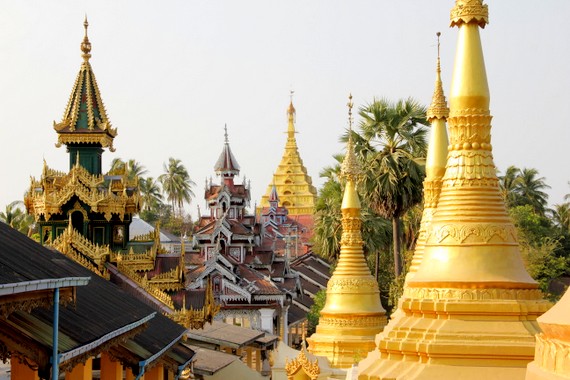
It’s three o’clock in the morning in Mawlamyine, Myanmar and we are looking for a place to sleep. Going from overnight bus to taxi van, we wind down the mountain with toward the moonlit shimmer of the Thanlwin river. The cabby takes us to Breezes Guest House, a crumbling colonial mansion on the waterfront. We stand in front of the ornate doorway with a raised fist, afraid to knock at this ungodly hour. Wrap, wrap, tap…Mr. Anthony, the 70-something innkeeper, opens the door and sleepily motions us in. “It’s $8 for a veeerrrrry small room,” he says, “or $40 for the Rubber Baron’s master suite with original furnishings.” Not quite sure where we were or what we were getting into, we took the closest, cheapest room and rested up for three unforgettable days in Mawlamyine and Ogre Island.
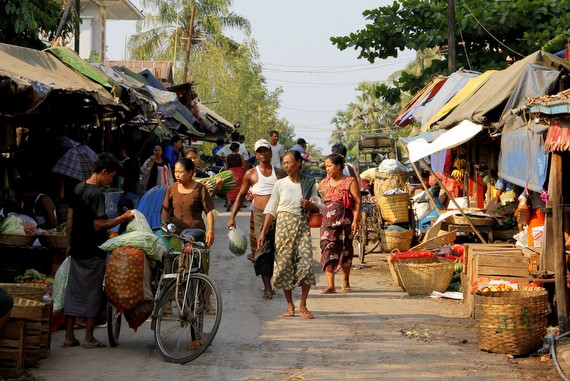
The temperature had risen to 102 degrees by the time we awoke but we motivated to explore the streets of what used to be called Little London. The Brits made Mawlamyine their first Burmese capital in the 1800s and gave it the trappings of home. Today their grand colonial buildings are selling anything from cell phones to chicken feed and the wide boulevards are tented markets. It’s not what it used be but it’s a fascinating place to explore. We watched the vendors and shoppers haggle while we took a two-hour lunch to beat the heat.
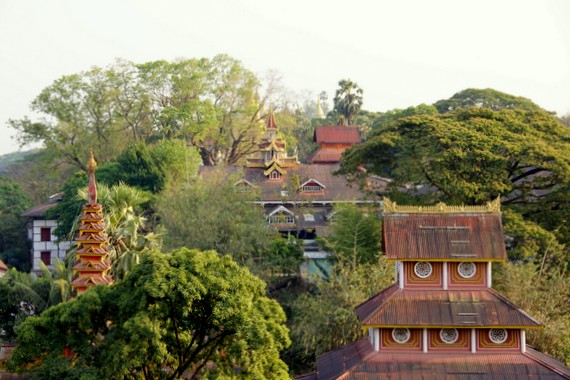
As the sun set we hiked toward Kyaikthanlan Paya, the tallest stupa and best vantage point in town. We took the Lonely Planet tip to approach the temple complex via the long-covered walkway that gracefully extends from Kyaik Than Lan Phayar Street. The Mon-style architecture was dazzling, from shrines to monasteries to homes, all nestled amongst the trees.
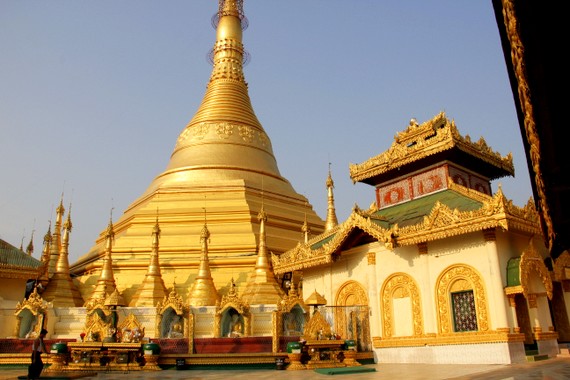
Kyaikthanlan Paya was like a miniature version of the dazzling Shwedagon Pagoda in Yangon, but with fabulous views of the riverside city.

If you sit long enough in Myanmar, friendly locals are bound to approach. As we were admiring the view, these adorable girls came up to us, curious about everything from our hair to our clothes to guide book, but mostly the sound of our voice. We exchanged basic English and Myanmar language lessons and unforgettable smiles.
The Ogre Island

An hour across the river from Mawlamyine sits Bilu Kyun, aka Ogre Island. If the name wasn’t intriguing enough, it’s home to 64 villages specializing in all sorts of crafts from coconut mats, bamboo hats, rubber bands, wooden instruments…made with virtually no supplies or electric tools. We took the morning ferry, cramming in with what seemed like a thousand people in a dingy and prayed we wouldn’t sink. Note: If you go here, you need to catch the 3pm boat home; foreigners aren’t allowed to sleep on the island (because of the Ogres, of course).

The island was too massive to walk, bike, or navigate on our own so we hopped in a truck with a local guide and the only other two tourists for a half-day tour. We made about five stops at various workshops, passing by lily-pond lakes, pastures, and tiny villages from a bygone era.
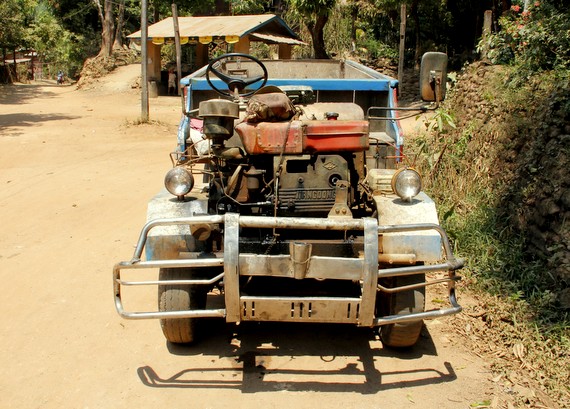
Horse and cart are the primary mode of transportation on the island, followed by bicycles, then cars made in what can only be described as “Mr-Potato-Head-style” construction. Motor, lights, fender, gas tanks, wheels, and wooden seats were strategically slapped together for some crazy amazing vehicles.
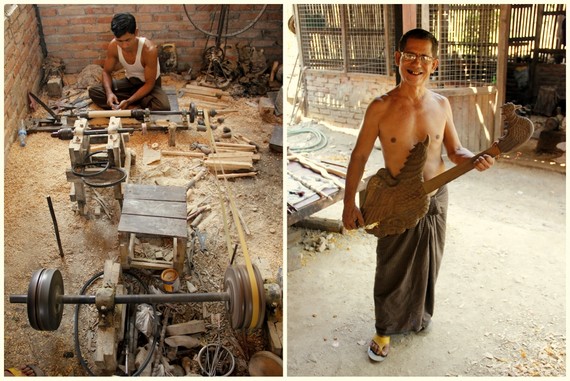
Our first stop on the craftsman tour was a resilient little wood-working studio. Using what I’m sure were spare parts from a “Mr. Potato Head car” gone wrong, this father-son team was whittling the most beautiful pipes, furnishings, and this rocking guitar in the shape of a Phoenix.
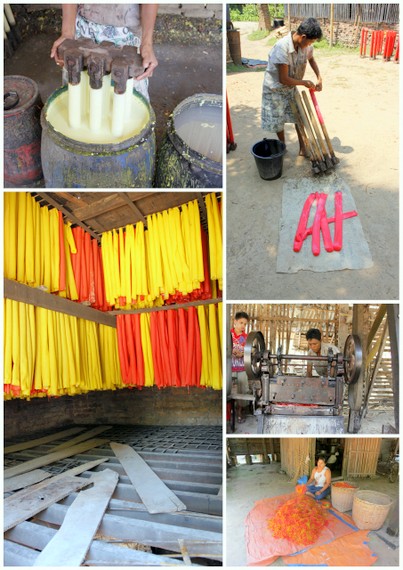
Have you ever thought about how a rubber band is made? No, because they are so simple, cheap, and ubiquitous–who would? Well, we have a heck of a lot more respect for the humble rubber band after watching its construction. Over the course of two days one must boil the tree sap, dye it, dip it, dry it, peel it, dry it again, dice it, then hand-separate thousands of springy rings. Rubber bands and their makers, we salute you!!
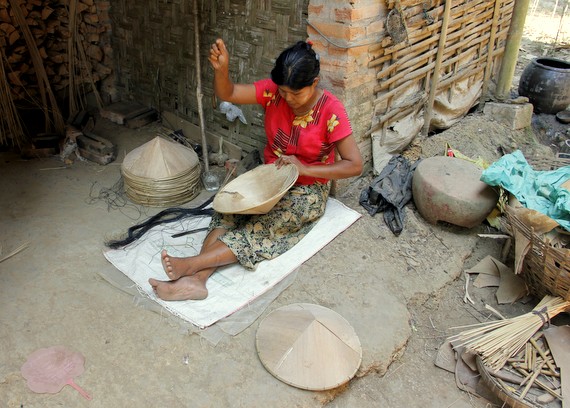
Next we went to a stilted home turned hat workshop. Similar conical hats can be found in other parts of Asia but we’d never seen them being built. Impressively enough no man-made materials are used; bamboo husks are the source for everything from the brim to the needles and thread.
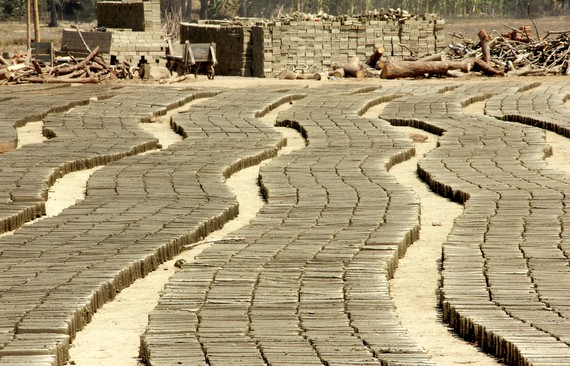
The time warp continued with a visit to the brick-making factory. In the extreme heat (100+ in the shade of a tree), men were hand-making mud bricks, drying them in the sun, then hauling them to a massive fire-burning kiln. And somehow they were still smiling.

Our time here was such an amazing reminder of how many things we take for granted–from cars to the rubber band. And an even greater reminder to appreciate everything you’ve got.


I love the picture of you with the children laughing behind you, what a sweet moment! The pagoda is stunning, so lavish especially in contrast to the simple lives of the villagers in your other pictures. It looks like a fascinating place!
Nancy we are so glad to have you along for the ride! That was such a sweet moment, it started with the litltlest girl. She just walked right up to us, not saying a word but smiling ear to ear. Myanmar is the country where we learned the most words because you constantly are conversing with people–English skills or not!
Great reading your blog about Mawlamyine as we are headed there in a few days. Do you by any chance have any information about boats running from Mawlamyine to Hpa-An at this time of year. Thanks so much for any info you can provide!
How exciting you are heading to Mawlamyine in a couple days! I think things can change so quickly so we wouldn’t want to give you specific info on ferries (we ultimately took the bus to Hpa-An). However, Mr.Anthony of Breezes Guest House is super tapped in to all things in the area, even if you don’t stay there, go chat with him! Best of luck and enjoy Hpa-An–that’s our next blog!
Thanks! We figured everything was subject to change so we went ahead and emailed Breezes to find out about the boat options. I’ll definitely check out your Hpa-An blog as that will be our next stop. Have a great trip!
I must admit I have not given a lot of thought into the production of a rubber band. Your posts are making me want to get back to Myanmar in a hurry and explore the places I wasn’t allowed to last time. This being one of them.
Mawlamyine was closed off then, eh? So crazy. There are still a number of places in the North that they won’t let you go but I’m sure so much great stuff has opened up since you went! We hope you get to go again soon and thanks so much for all your awesome and thoughtful comments!
Beautiful read! Happy to have found a travel blog run by wonderful storytellers. As someone who grew up in post-colonial Calcutta, I’m very interested in the changing tides of such towns and cities, as old British buildings and cultures get incorporated into local ones, creating such interesting and distinct local flavours. I’ve not been to Myanmar yet, which is a shame as it’s so close to where I grew up! to-be-remedied.
You suck!
Great anecdote. But it wasn’t Phoenix that you found in Guitar-shaped that was hansa bird, tropical migratory birds widely found in Northern Myanmar. Thumb up your inputs and please go ahead.
KP
Wow, Mawlamyine looks incredible. I had heard of Myanmar before but never this place…thanks for sharing your visit with us, now I need to get there myself!